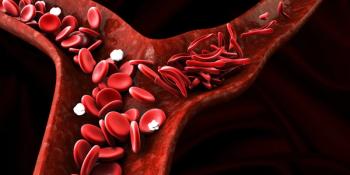
Galcanezumab: A New Calcitonin Gene-Related Peptide for Treating Migraine
Millions worldwide dread the onset of debilitating migraines. There is a new drug class on the horizon that is thought to put a stop to the root of migraines.
A migraine is a disabling, neurologic disease characterized by recurrent episodes of severe headache and/or throbbing recurring pain accompanied by other symptoms, including nausea, vomiting, extreme sensitivity to light and sound, and changes in vision.1,2 Migraine attacks last between 4 hours and 72 hours with symptom expression that varies between individuals and each attack.1,3
More than 30 million American adults have migraines, with 3 times more women affected by them compared to men.1 According to the Medical Expenditures Panel Survey, the total unadjusted cost associated with migraines in the United States is estimated to be as high as $56 billion annually, yet they remain under-recognized and under-treated, as there is no test or biomarker to confirm diagnosis.
There is currently no single cure for migraines.2 Treatment options are aimed at alleviating symptoms, and include simple analgesics (acetaminophen, NSAIDs), combination analgesics (Midrin, Fioricet), opioid analgesics (Stadol, meperidine), triptans, TCA’s and topiramate. However, these options are not ideal as migraine recurrence rate after utilizing these medications is high. From this unmet need, several new options designed for migraine prevention are in the pipeline. On September 27, 2018, the
Focus on calcitonin gene-related peptide (CGRP) as a potential migraine target began after failure of substance P-blocking drugs. The 37-amino acid sequence was discovered by chance after researchers realized it was produced in the brain by alternative gene splicing of calcitonin.4 After finding prominent CGRP expression in brain pathways of pain management and blood flow regulation, its involvement in migraines was more relevant.
Researchers found CGRP to be a powerful vasodilator of cerebral blood vessels when released from the trigeminovascular system, and the only significant peptide released prior to a migraine attack.5 In a 2002 study, when CGRP was injected into the blood of individuals that experience migraine attacks they developed migraine-like headaches within hours, whereas individuals without a history of migraines developed at most a mild headache.6 This led researchers to believe that individuals who experience migraines are sensitive to the effects of CGRP and inspired the creation of a class of preventative migraine medication.
Galcanezumab-gnlm is a human immunoglobulin G4 (IgG4) monoclonal antibody that binds to the CGRP receptor and antagonizes CGRP alpha and beta receptor function.7-9 CGRP is an ideal target for migraine pathophysiology as it is distributed throughout the nervous system, and concentration levels are elevated prior and during acute and chronic attacks. Centrally, CGRP is involved in nociceptive transmission through second and third order neurons and pain modulation in the brainstem. Peripherally, CGRP mediates vasodilation through smooth muscle receptors.7,8
The recommended dose for Emgality is 240 mg (2 consecutive SC injections of 120 mg each) once as a loading dose, followed by monthly doses of 120 mg injected subcutaneously. Hypersensitivity reactions (i.e. rash, urticaria and dyspnea) have been reported with Emgality in clinical studies. The most commonly reported adverse reactions (incidence ≥ 2% and at least 2% greater than placebo) were injection site reactions. Annual cost of treatment is $6,900, but patients with commercial insurance are candidates to receive Emgality for up to 12 months free.
Efficacy and safety of Emgality was demonstrated in two Phase 3 clinical trials in patients with episodic migraine (EVOLVE-1 and EVOLVE-2) and one Phase 3 clinical trial in patients with chronic migraine (REGAIN).8-12 EVOLVE-1 and EVOLVE-2 were 6-month, double blind, placebo-controlled studies that enrolled a total of 1773 adult patients with episodic migraine (defined as 4-14 migraine headache days [MHDs] per month).11,12 Participants were randomized to once-monthly placebo, Emgality 120 mg after an initial loading dose of 240 mg, or Emgality 240 mg. Both studies excluded patients on any other migraine preventative treatment, patients with medication overuse headache, patients with electrocardiogram abnormalities compatible with an acute cardiovascular event and patients with a history of stroke, myocardial infarction, unstable angina, percutaneous coronary intervention, coronary artery bypass grafting, deep vein thrombosis or pulmonary embolism within 6 months of screening. As there are CGRP receptors within the cardiovascular system, these exclusions ensure that any effect seen was due to the newly proposed mechanism of action.
Primary endpoint was the mean change from baseline in the number of monthly MHDs over months 1 to 6 in the intent-to-treat study population. For EVOLVE-1, galcanezumab 120 mg was given once monthly for 6 months, with participants receiving a loading dose of 240 mg (2 injections of 120 mg each) administered at visit 3 only.11 Baseline migraine headache days for Emgality was 9.2 and placebo was 9.1. Mean change from baseline was -4.7 days (N=210) for Emgality 120 mg compared to -2.8 days (N=425) for placebo (p<0.001). Results showed at least a 50% reduction in MHDs in any given month of 62% (N=210) for Emgality 120 mg was seen compared to 39% (N=425) for placebo (p<0.001), a 75% reduction in MHDs in any given month of 39% (N=210) for Emgality 120 mg compared to 19% (N=425) for placebo (p<0.001) and a 100% reduction in MHDs in any given month of 16% (N=210) for Emgality 120 mg compared to 6% (N=425) for placebo (p<0.001).11
For EVOLVE-2, galcanezumab 240 mg was given as a loading dose followed by galcanezumab 120 mg once a month for 5 months by SC injection.12 Baseline migraine headache days for Emgality was 9.1 and placebo was 9.2. Mean change from baseline was -4.3 days (N=226) for Emgality 120 mg compared to -2.3 days (N=450) for placebo (p<0.001). Results showed at least a 50% reduction for MHDs in any given month of 59% for Emgality 120 mg compared to 36% (N=450) for placebo (p<0.001), a 75% reduction in MHDs in any given month of 34% (N=226) for Emgality 120 mg compared to 18% (N=450) for placebo (p<0.001) and a 100% reduction in MHDs in any given month of 12% for Emgality 120 mg compared to 6% (N=450) for placebo (p<0.001). Injection site pain was the most common treatment-emergent adverse event, reported at similar rates in all treatment groups. Both galcanezumab doses had significantly more injection site reactions and injection site pruritus, and the 240 mg group had significantly more injection site erythema compared to placebo.
REGAIN was a 3-month, double blind, placebo-controlled study that enrolled 1113 adult patients with chronic migraine (defined as ≥15 headache days per month with ≥8 migraine days per month). Participants were randomized to receive once-monthly placebo, Emgality 120 mg after an initial loading dose of 240, or Emgality 240 mg. A subset of patients (15%) continued one concomitant migraine preventive medication regardless of study group. Patients exclusion criteria matched that of EVOLVE clinical trials. Primary endpoint was the mean change from baseline in the number of monthly MHDs over the 3-month treatment period. Baseline MHDs for Emgality was 19.4 and placebo was 19.6 and mean change from baseline was -4.8 days (N=273) for Emgality 120 mg compared to -2.7 days (M=538) for placebo (p<0.001). Results showed at least a 50% reduction in MHDs in any given month of 28% (N=273) for Emgality 120 mg compared to 15% (N=538) for placebo (p<0.001). Emgality 120 mg was not significantly better than placebo for the majority of patients with 75% and 100% reduction from baseline.8,9
Limitations of these studies are that patients were not tested to determine whether galcanezumab could be effective as an adjunctive treatment, concurrent with other treatment options. Both EVOLVE and REGAIN studies were conducted in North America, primarily United States, which limits generalizability of these results to patients in other geographies. Caution should be used when treating patients with acute cardiovascular events and/or serious cardiovascular risk since patients with co-morbid cardiovascular conditions and cardiovascular risk were not included. There is insufficient human data to establish the safety of galcanezumab during pregnancy since pregnant women were excluded.
To conclude, in phase 3 trials among patients with episodic or chronic migraine, galcanezumab users saw greater reductions in monthly migraine days relative to placebo users and were more likely to achieve a 50% reduction in monthly migraine days. Those with episodic migraines who took galcanezumab were more likely to achieve 75% and 100% reductions in monthly migraine days over placebo recipients.8-12
Good candidates for this medication include individuals who have failed several migraine therapies, as a last-line option to improve quality of life.
This article was co-written with Jacqueline Pratt Cleary, PharmD, BCACP, and Nirvana Prashad, PharmD candidate.
Nirvana T. Prashad is a 2019 Pharm.D candidate at Albany College of Pharmacy and Health Sciences in Albany NY. After pharmacy school, she would like to pursue a pharmaceutical fellowship or work in the community setting. Her interests include teaching and fitness.
Jacqueline Cleary, PharmD, BCACP is an Assistant Professor of Pharmacy Practice at Albany College of Pharmacy and Health Sciences. Dr. Cleary completed a PGY-1 at Sentera Hospital System and a PGY-2 in Pain and Palliative Care at the Albany Veterans Hospital. Her teaching and research interests include pain management, pharmacogenomics, naloxone, medication assisted treatment, and palliative care.
References
- Lipton RB, Bigal ME, Diamond M, et al. Migraine Prevalence, Disease Burden, and the Need for Preventive Therapy. Neurology. 2007;68:343-349.
- Raval AD, Shah A. National Trends in Direct Health Care Expenditures among US Adults with Migraine: 2004 to 2013. J Pain. 2017;18:96-107.
- Diamond S, Bigal ME, Silberstein S. Patterns of Diagnosis and Acute and Preventative Treatment for Migraine in the United States: Results from the American Migraine Prevalence and Prevention Study. Headache. 2007;47:355-363.
- Karsan N, Goadsby PJ. Calcitonin Gene-Related Peptide and Migraine. Curr Opin Neurol. 2015;28:250-254.
- Edvinsson L. The CGRP Pathway in Migraine as a Viable Target for Therapies. Headache. 2018 May;58 Suppl 1:33-47.
- Lassen LH, Haderslev PA, Jacobsen VB et al. CGRP May Play a Causative Role in Migraine. Cephalalgia. 2002 Feb;22(1):54-61.
- Raffaelli B, Reuter U. The Biology of Monoclonal Antibodies: Focus on Calcitonin Gene-Related Peptide for Prophylactic Migraine Therapy. Neurother. 2018 Apr;15(2):324-355.
- Zhu Y, Liu Y, Zhao J et al. The Efficacy and Safety of Calcitonin Gene-Related Peptide Monoclonal Antibody for Episodic Migraine: A Meta-Analysis. Neurol Sci. 2018 Sep; ahead of print.
- Monteith D, Collins EC, Vandermeulen C et al. Safety, Tolerability, Pharmacokinetics and Pharmacodynamics of the CGRP Binding Monoclonocal Antibody LY2951742 (Galcanezumab) in Healthy Volunteers. Front Pharmacol. 2017 Oct;8(1):740-745.
- Oakes TMM, Skljarevski V, Zhang Q et al. Safety of Galcanezumab in Patients with Episodic Migraine: A Randomized Placebo-Controlled Dose-Ranging Phase 2b Study. Cephalalgia. 2018 May;38(6):1015-1025.
- Stauffer VL, Dodick DW, Zhang Q et al. Evaluation of Galcanezumab for the Prevention of Episodic Migraine: The EVOLVE-1 Randomized Clinical Trial. JAMA Neurol. 2018 Sep;75(9):1080-1088.
- Skljarevski V, Matharu M, Millen BA, Ossipov MH, Kim BK, Yang JY. Efficacy and Safety of Galcanezumab for the Prevention of Episodic Migraine: Results of the EVOLVE-2 Phase 3 Randomized Controlled Clinical Trial. Jama Neurol. 2018 Jul;38(8):1442-1454.
Newsletter
Stay informed on drug updates, treatment guidelines, and pharmacy practice trends—subscribe to Pharmacy Times for weekly clinical insights.



















































































































































































































